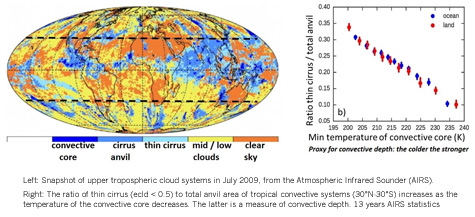New Observational Metrics Linking Convection to Horizontal Structure of Cirrus Anvils
Submitter: Claudia Stubenrauch, Laboratoire de Météorologie Dynamique IPSL
Area of Research: Upper tropospheric clouds and convection
GEWEX Panel: GEWEX Data and Assessments Panel (GDAP) and the Global Atmospheric System Studies (GASS) Panel
Journal Reference:
Protopapadaki, E.-S., C. J. Stubenrauch, and A.G. Feofilov, 2017. Upper Tropospheric cloud Systems derived from IR Sounders: Properties of Cirrus Anvils in the Tropics. Atmosph. Chem. Phys., 17, 3845-3859, doi:10.5194/acp-17-3845-2017.
Science:
Covering about 30% of the Earth, upper tropospheric clouds play a crucial role in the climate system by modulating the Earth’s energy budget and heat transport. When originating from convection, they often form organized systems. A cloud system approach, based on physical properties retrieved from spaceborne hyperspectral IR sounder measurements, made it possible to link the cirrus anvil properties of mature convective systems to the convective depth. In agreement with other studies, the size of the convective systems increases in general with convective depth. Moreover, this analysis revealed for the first time that the ratio of thin cirrus over total anvil area increases with increasing convective depth.
Impact:
Changes in the horizontal emissivity structure in deep convective systems with changing convective depth might have important implications for upper tropospheric cloud feedbacks, in relation to intensified convection in a warming climate.
The observed relationships also provide promising observational diagnostics of convective detrainment processes in climate models.
This data base of upper tropospheric cloud systems is being complemented by other data within the framework of the GEWEX Process Evaluation Study on Upper Tropospheric Clouds and Convection (UTCC PROES, GEWEX News, May 2017), a new GEWEX activity to advance our understanding on climate-related physical processes of upper tropospheric clouds and convection.
Summary:
Spaceborne hyperspectral IR sounder observations are auspicious for the retrieval of the physical properties of upper tropospheric (UT) clouds, because they are also sensitive to cirrus (thin ice clouds), down to an IR optical depth of about 0.1, day and night. A cloud system approach, based on retrieved physical properties, made it possible to link the cirrus anvil properties of mature convective systems to the convective depth. The latter was approximated by the minimum temperature within the convective core. By using 13 years of statistics from measurements of the Atmospheric Infrared Sounder (AIRS), it was shown that colder convective systems (those rising higher) have a larger maximum rain rate (a tendency more marked over land), as well as larger cirrus anvils (a tendency more marked over ocean), in agreement with previous studies. Furthermore, the novel cloud system approach provides a unique opportunity to study the horizontal emissivity structure within anvils. Higher rising convective systems include in general more thin cirrus in their anvils. This provides promising observational metrics for studying detrainment processes.
Link to the Original Research Publication or Website: https://www.atmos-chem-phys.net/17/3845/2017/


